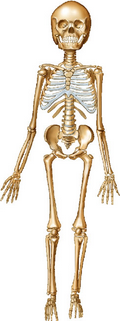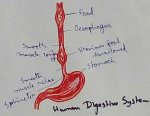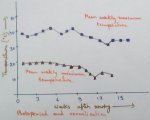Body Systems
We will learn about our different body systems.
A group of organs, working together to do some major work for our body, forms a system. The work is carried on in a very systematic manner from one organ to another. A body system keeps functioning whether we are awake or asleep.
Our body has several systems. Different systems help our body to perform different functions to live
These systems are:
(i) The Skeletal System
(ii) The Muscular System
(iii) The Respiratory System
(iv) The Digestive System
(v) The Circulatory System
(vi) The Excretory System
(vii) The Nervous System
(viii) The Reproductive System
Skeletal System:
The skeletal system is a framework of 206 bones. An adult human body has 206 bones.
|
They are joined together and form a framework called skeleton. It gives form, shape, size and support to our body. The bones help the body in movements. It also protects the soft organs inside our body. Our body cannot stand upright without a skeleton. The skull protects delicate organs like the brain and eyes. The ribs protect the lungs and heart. In the skeleton, there are many joints. A joint is a place where two or more bones meet. The joints help us to move our body parts. Actually, our bones are joined together in such a way that most of them are able to move over each other. So, we are able to blend, run, move, etc. |
Note: The largest bone in our body is the hip bone. In fact, it is made of six bones joined firmly together.
Muscular System:
Our body has more than 600 muscles. The ends of most of the muscles are joined to the bones. Along with the bones, muscles help the body to move, work and do other activities. Actually, our muscles pull our bones and make them move. Muscles also give shape to our body. So, they are responsible for all our body movements.
Respiratory System:
We all breathe to live. The organs involved in our breathing system are the nose, windpipe, and the lungs.
|
We breathe in air through the nose. While breathing air enters through our nose and reaches the lungs through the windpipe. The lungs take in oxygen from air and send it to blood. Oxygen reaches to the whole body through the blood. This oxygen burns the food we eat, to give us energy. The air breathed out contains more carbon dioxide and other impurities. The fine hair in the nose blocks the dust particles contained in the air. We must breathe through the nose and not through the mouth. Breathing purifies our blood and helps us to obtain energy. |
Note: We breathe about 22,000 times a day.
Digestive System:
The organs involved in this system are the mouth, food pipe, stomach and the small and large intestines.
When we are hungry we eat. The food we eat is digested by a group of organs that forms the digestive system. The conversion of food we eat is the process of digestion that changes food into a simple form.
The process of digestion begins with the chewing of the food with our teeth in the mouth. Saliva mixes with the food in the mouth. Saliva is a juice present in our mouth. This makes the food soft and easy to swallow.
|
Digestion starts in our mouth. From the mouth the food enters the food pipe and then goes into the stomach. The food stays in the stomach for a few hours and the food mixes with digestive juices. These juices are produced in the glands of the walls of the stomach. Here it changes into a thick liquid. A part of digestion takes place here. The food is completely broken down into a simple form in the small intestine. The digested food is absorbed by the blood. The undigested food passes into the large intestine and it comes out of the body through the anus as waste. |
Note: The digestive system from the mouth to anus is 9 meters long.
Circulatory System:
The heart, blood vessels and blood are involved in this system.
|
The heart pumps blood and the blood goes to all the parts of the body through small and large tubes called blood vessels. Blood circulation is very important for our life. Digested food and oxygen also reach the different organs of the body through these vessels. The blood supplies oxygen and nourishment. It is our circulatory system which carries back all the waste material from the different parts of the body. |
Note: The adult human body contains 5 to 6 litres of blood.
Excretory System:
We eat so many things every day. They form waste materials. The organs involved in this system are skin, lungs, kidneys and the large intestine. These organs help in removing the body wastes regularly because these waste materials are useless for our body. They must come out of our body otherwise they will cause us diseases. Our excretory system does this important work.
The skin throws out salt and water as sweat.
The lungs expel carbon dioxide and other impurities out of our body while breathing out.
The bean shaped organs called kidneys throw out waste material out of our body as urine. Our kidneys purify our blood.
The large intestine throws out solid waste (faeces) through the anus.
This keeps the body clean and healthy.
Nervous System:
As we know, different parts of our body perform different work for us. This system involves nerves, spinal cord and the brain. The brain controls and guides all the actions of all parts of the body.
The nervous system is connected to every part of the body. Messages are carried from and to every part of the body through the nerves. The brain and nerves form our nervous system. Our actions and reactions are all controlled by this system.
Reproductive System:
This system produces babies through different reproductive systems which men and women have. This system is responsible for existence of life on our Earth.
From Body Systems to HOME PAGE
Recent Articles
-
Eleventh Grade | Eleventh Grade Science | Eleventh Grade Math
Jun 27, 25 12:26 AM
Eleventh grade biology has been designed in accordance with the recommended topics. We will cover all the topics in biology very exciting and interesting way. -
Explain Digestion of Food | Salivary Glands | Oesophagus | Stomach
Jun 27, 25 12:20 AM
Before the digestion is start by the different enzymes secreted from the different digestive glands food must be turned and chut or mixed with saliva inside the mouth. -
Explain Human Digestive System | Mouth | Tongue | Pharynx | Teeth
Jun 21, 25 01:15 PM
Digestive system is a system of alimentary canal and digestive glands. Alimentary canal- alimentary canal is a tube of variable diameter having muscular wall and glandular epithelial tissues which sta… -
Vernalisation in Plants | Definition | Mechanism | Devernalization |
Jun 18, 25 01:34 PM
Definition of vernalisation- The change of flowering habit due to the low temperature treatment is known as vernalisation. This is a physiological process which was denoted by Clipart in 1857 invite b… -
The Food We Eat | Food we Get from Plants and Animals | Carbohydrates
Jun 15, 25 03:20 PM
What are the food that we should eat? Find out the names of ten food items in the word maze. Write the names in the correct column of the table given below. Food we get from plants Food we get from an…











New! Comments
Have your say about what you just read! Leave me a comment in the box below.